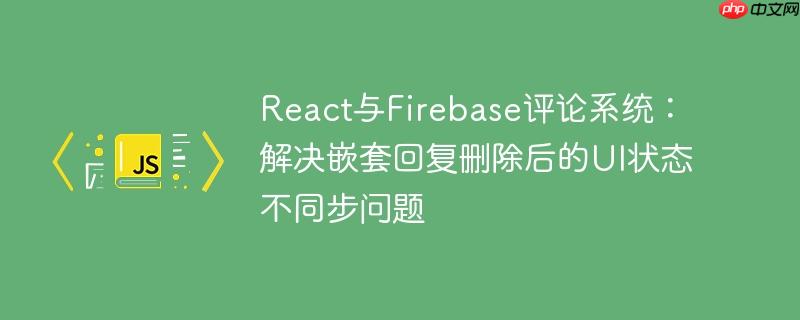
在构建一个具有评论和回复功能的系统时,我们通常会遇到一个挑战:当用户删除一个回复时,后端数据库(如firebase firestore)中的数据已成功移除,但前端ui却未能立即反映这一变化,需要手动刷新页面才能看到正确状态。这通常指向了react状态管理与数据流设计中的深层问题。
当前实现中,数据结构如下:
核心问题代码存在于RepliesSection.js和Comments.js之间的数据流。Comments.js通过Firebase的onSnapshot实时监听评论集合,并将获取到的评论数据 (comments state) 传递给SingleComment组件。SingleComment再将评论的replies数组作为onReplies prop传递给RepliesSection。
RepliesSection组件的关键代码如下:
const RepliesSection = ({ onReplies, /* ... */ }) => {
const [repliess, setReplies] = useState(onReplies); // 问题所在
// ...
const deleteReply = async (replyId) => {
// ... 从Firestore获取评论文档
const updatedReplies = getSingleCommentData[0].replies.filter(
(reply) => reply.replyId !== replyId
);
await updateDoc(docRef, { replies: updatedReplies });
setReplies(updatedReplies); // 更新本地状态
};
// ...
return (
<Stack spacing={2} width="800px" alignSelf="flex-end">
{repliess && Array.isArray(repliess) && repliess.length > 0 &&
repliess.map((rep) => { /* ... */ })}
{/* ... */}
</Stack>
);
};这里存在几个关键问题:
要解决上述问题,核心思想是遵循React的“单一数据源”原则,并采用受控组件模式。
RepliesSection不应该拥有自己的repliess状态。它应该直接渲染从props接收到的onReplies数据。这意味着删除useState(onReplies)以及所有对setReplies的调用。
RepliesSection.js 改造示例:
// ...
const RepliesSection = ({ onReplies, onClicked, onTar, onPass, avatar, displayName, ava, postedBy, comId, onCommentDeleted, onDeleteReplyFromParent }) => {
// 移除本地状态 repliess 和 setReplies
// const [repliess, setReplies] = useState(onReplies);
// ... 其他逻辑不变
// deleteReply 函数应该被移到 Comments.js 或通过 prop 传递下来
// const deleteReply = async (replyId) => { /* ... */ };
return (
<Stack spacing={2} width="800px" alignSelf="flex-end">
{/* 直接使用 onReplies prop */}
{onReplies && Array.isArray(onReplies) && onReplies.length > 0 &&
onReplies.map((rep) => {
// ...
return (
<OwnReply
// ... 其他 props
onDel={onDeleteReplyFromParent} // 将删除回复的函数从父组件传递下来
// ...
/>
);
})
}
{/* ... */}
</Stack>
);
};
export default RepliesSection;将删除回复的逻辑提升到Comments.js组件。这样,当回复被删除时,Comments组件可以直接更新其核心的comments状态,并依赖onSnapshot机制来确保UI与Firestore同步。
Comments.js 改造示例:
import React, { useState, useEffect, useContext } from "react";
import {
getFirestore, collection, where, query, orderBy, onSnapshot, doc, getDoc, updateDoc
} from 'firebase/firestore'
// ... 其他导入
const Comments = ({ recipeId }) => {
const [commentsLoading, setCommentsLoading] = useState(true);
const [comments, setComments] = useState([]);
const db = getFirestore()
const commentsRef = collection(db, 'comments')
// ... 其他状态和上下文
const handleCommentDeleted = (id) => {
const updatedComments = comments.filter((comment) => comment.id !== id);
setComments(updatedComments);
};
// 新增:处理回复删除的函数
const handleDeleteReply = async (commentId, replyIdToDelete) => {
try {
const commentDocRef = doc(db, 'comments', commentId);
const commentSnap = await getDoc(commentDocRef);
if (commentSnap.exists()) {
const commentData = commentSnap.data();
const updatedReplies = commentData.replies.filter(
(reply) => reply.replyId !== replyIdToDelete
);
await updateDoc(commentDocRef, {
replies: updatedReplies
});
// 注意:这里不需要手动 setComments,因为 updateDoc 会触发 onSnapshot,
// onSnapshot 会自动获取最新数据并调用 setComments。
// 确保 onSnapshot 的回调函数能够正确处理更新后的数据。
}
} catch (error) {
console.error("Error deleting reply:", error);
}
};
useEffect(() => {
const q = query(collection(db, "comments"), where("recipeId", "==", recipeId), orderBy("createdAt", "desc"));
const unsubscribe = onSnapshot(q, (querySnapshot) => {
const getCommentsFromFirebase = [];
querySnapshot.forEach((doc) => {
getCommentsFromFirebase.push({
id: doc.id,
...doc.data()
})
});
setComments(getCommentsFromFirebase)
setCommentsLoading(false)
});
return unsubscribe
}, [recipeId]);
// ... 其他渲染逻辑
return (
< div >
< Container maxWidth="md" >
<Stack spacing={3}>
{comments && comments.map((comment) => {
return (
<SingleComment
key={comment.id}
onPass={comment}
onCommentDeleted={handleCommentDeleted}
onDeleteReply={handleDeleteReply} // 将删除回复的函数传递下去
/>
);
})}
</Stack>
</Container >
</div >
);
};
export default Comments;SingleComment需要将onDeleteReply prop传递给RepliesSection。OwnReply则直接调用从RepliesSection接收到的onDel prop。
SingleComment.js 改造示例:
// ...
const SingleComment = ({ onPass, onCommentDeleted, onDeleteReply }) => { // 接收 onDeleteReply
// ...
return (
<Card sx={{ mt: "1em", }}>
{/* ... */}
{
<RepliesSection
onPass={onPass}
onReplies={replies} // 直接使用 onPass.replies
// ... 其他 props
onDeleteReplyFromParent={onDeleteReply} // 将 onDeleteReply 传递给 RepliesSection
/>
}
</Card >
);
};
export default SingleComment;OwnReply.js 改造示例:
// ...
const OwnReply = ({ onCommentDeleted, onDel, /* ... */ comId, replyId, /* ... */ }) => { // 接收 onDel
// ...
return (
<>
<ConfirmDelete
onOpen={openModal}
onClose={handleClose}
comId={comId}
replyId={replyId}
onDel={onDel} // 直接调用 onDel prop
// ... 其他 props
/>
<Card>
{/* ... */}
<Stack direction="row" spacing={1}>
<Button
startIcon={<Delete />}
sx={{ /* ... */ }}
onClick={() => {
handleOpen(); // 触发 ConfirmDelete 模态框
}}
>
Delete
</Button>
{/* ... */}
</Stack>
{/* ... */}
</Card>
</>
);
};
export default OwnReply;ConfirmDelete.js 改造示例:
// ...
const ConfirmDelete = ({ setReplyId, replyId, onDel, onOpen, onClose, comId, onCommentDeleted, /* ... */ }) => {
// ...
const deleteHandler = async () => {
// ... 删除评论的逻辑
};
return (
<Dialog open={onOpen} onClose={onClose}>
{/* ... */}
<Stack direction="row" display="flex" justifyContent="space-between">
<Button
// ...
onClick={onClose}
>
No, cancel
</Button>
<Button
// ...
onClick={() => {
// 根据是否是回复删除,调用不同的处理函数
if (onDel && replyId && comId) { // 检查 onDel 是否存在且是删除回复
onDel(comId, replyId); // 调用从 Comments 传递下来的删除回复函数
} else {
deleteHandler(comId); // 调用删除评论函数
}
onClose(); // 关闭模态框
}}
>
Yes, delete
</Button>
</Stack>
</Dialog>
);
};
export default ConfirmDelete;通过将RepliesSection改造为受控组件,并将删除回复的逻辑集中到Comments.js,我们解决了嵌套回复删除后UI状态不同步的问题。这种模式确保了数据流的清晰、可预测,并充分利用了Firebase onSnapshot的实时更新能力。这种设计不仅提高了代码的可维护性,也为用户提供了更流畅、响应更快的体验。在复杂的React应用中,理解并实践受控组件和单一数据源原则对于构建健壮的UI至关重要。
以上就是React与Firebase评论系统:解决嵌套回复删除后的UI状态不同步问题的详细内容,更多请关注php中文网其它相关文章!

每个人都需要一台速度更快、更稳定的 PC。随着时间的推移,垃圾文件、旧注册表数据和不必要的后台进程会占用资源并降低性能。幸运的是,许多工具可以让 Windows 保持平稳运行。

Copyright 2014-2025 https://www.php.cn/ All Rights Reserved | php.cn | 湘ICP备2023035733号